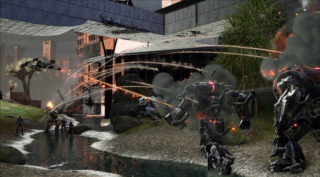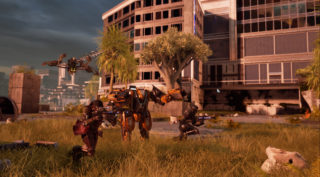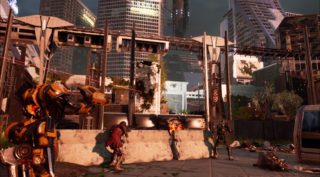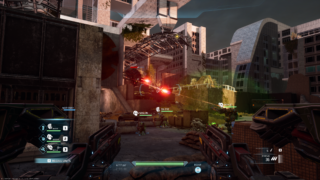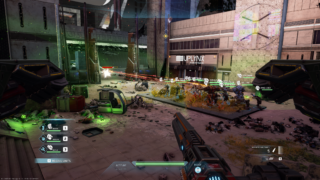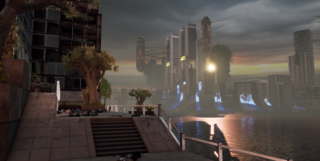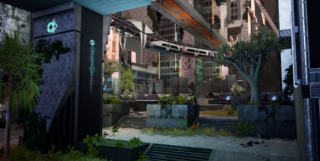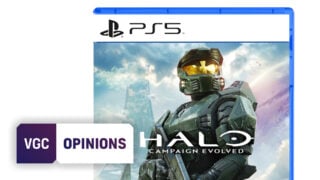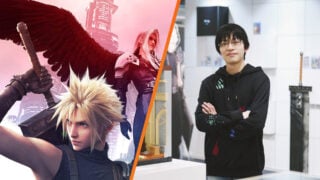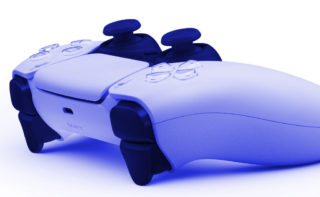Interview: Halo’s co-creator on building a new universe with Disintegration
Marcus Lehto discusses single-player, remote working and SSD tech

Marcus Lehto, the co-creator of Halo, currently has the unique experience of having to complete his next game universe from home.
Like most game studios during the COVID-19 pandemic, Letho’s Washington-based V1 Interactive is working remotely.
As Bungie‘s former creative art director points out, social distancing has been implemented at a difficult time for the Disintegration team. V1 is currently attempting to squash the remaining bugs and performance issues during its final phase of development – tasks which are useful to have a team together for.

“But we’re in a better place than many other games,” he adds. With some 30 employees, the company is lean and crucially, it already practised a remote working policy before the pandemic. Bigger studios will have it worse, says Lehto.
“It’s troubling for me because I’ve called and talked to friends of mine at other studios and they’ve had layoffs and other issues as a result of this. It’s really affecting everyone in different ways and it’s not over.”
VGC spoke to the V1 president via video call about Disinegration’s recently revealed single-player campaign and more.
You held a multiplayer beta earlier this year. How useful was that for you?
We learned a lot out of the multiplayer tech beta. Our initial goals with that were to stress test the servers and verify that they would work properly when we updated them live. All of that was real successful.
We knew that the game was not finished at that time and there was quite a bit of messaging left to be addressed with regards to how units were moving around the world and what the game rules were. So we knew initially there were a lot of things that would probably confuse players, but on top of that, there was so much valuable data we got from the community.
As they played through the game they gave us really great feedback on what they liked and didn’t like, how responsive their ground units were to the things they wanted them to do tactically, to the way the grav cycles moved around the environment and even the game rules.
We took all of that data – and there was lots of it – and we collated it into about five or six comment ‘buckets’ of feedback, and then we built tasks for ourselves to address pretty much all of the major things that bugged people, or issues they highlighted that we also agreed with.
You unveiled Disintegration with multiplayer and now eight months later you’ve finally shown single-player. Is the order of your marketing campaign any indication of which mode you’re prioritising?
No, it’s not as a matter of fact. It was necessary because there were so many technical hurdles for us to iron out on the multiplayer side of things that it made more sense for us to open up with that and see what kind of things broke. The ultimate goal was to break this thing as many ways as we possibly could then fix it.
We began the construction of this entire game from the story point. I had started building the fiction for it over six years ago; all of the backstory lore, all of the things that I thought would define an interesting universe for the game to exist in. And then we started with the story campaign as we began to build the game out. It wasn’t until we got some of the core mechanics of that campaign solidified in a way that we were excited about that we began working on the multiplayer component.
Six years sounds like a long time to spend on the story. Just how cinematic is the single-player campaign?
Well, keep in mind when I say six years, it was six years ago that I began working on the fiction for the game, but it’s not like I worked on it straight from there all the way to where we are now. I explored a lot of different game ideas but I kept coming back to the universe that I ultimately call Disintegration, because it spoke to me stronger than some of the other game ideas that I was working on at that time.
“I explored a lot of different game ideas but I kept coming back to the universe that I ultimately call Disintegration, because it spoke to me stronger than some of the other game ideas that I was working on at that time.”
Then about four-and-a-half years ago I began working on a prototype with two college students. It was just myself building all the content and animating it, then college student engineers writing all the code. We were using Unity at that time to build a prototype and I wanted to take our time. We took about a year and a half to build the prototype, make sure it was fully playable and that I could illustrate clearly what the design mechanics were for the game, and then we pitched it around. Fortunately, we were able to bump into Private Division along the way.
So the real construction – the meat of the story campaign – didn’t start until about three-and-a-half years ago when I was able to formally start the studio and hire people. My cinematics director Lee Wilson, who I have worked with for many years at Bungie, was able to be hired and together we began the construction of the actual story that we tell throughout the campaign.
Visually the game very clearly has your fingerprints on it, which means it’s inevitably evocative of Halo. Were there any old concepts for that series that made it into Disintegration?
There’s nothing in particular that I can think of that was an element from Halo. Having worked on Halo for almost 16 years I felt like I exhausted all of my Halo stuff that I wanted to do over the expanse of that time.
With Disintegration there was an opportunity for me to express the aesthetics of what I love about characters, vehicles and the world. So my thumbprints are definitely there, but there’s nothing that translated directly from the Halo universe.

You have some original Halo art on your wall. It must feel weird to see 343 seemingly revisiting those original concepts with Infinite?
I speak to the guys on the concept team and they’re like, ‘gosh, Marcus, we’re digging up some of your old work and we’re having to recreate some of that stuff’ and it’s kind of fun. On one hand, I think they’re like, ‘why didn’t we do this kind of thing before?’ But they needed to make it their own when they first started off with Halo 4. It’s really interesting to see how it’s evolved over time. I want to see more of what they’re doing.
For people familiar with the multiplayer beta, what are the biggest changes they’re going to notice?
There are several things that they are going to notice. We opened up the FOV a little bit, we changed the grav cycle speeds, we dramatically improved the responsiveness of the ground units so that when you need their abilities, they’re there. The ability usage itself has been dramatically improved, so there’s no interruption of that ability because of something in the environment or another character getting in the way. Just even the AI and the way it functions in the environment is smarter. There are quite a few improvements overall, in addition to map improvements, fixing exploits and that type of thing.
What’s it like finishing a game from home?
It’s very hard but we’re making it work. We stay connected as a team as well as we possibly can on Slack, Discord and Hangouts to share screens with one another. We also have a hangout in the afternoon just to chat to one another and feel like we have some sort of human contact. But the hardest part is that getting through the final phase of the game is all about bug fixing, performance tuning and really complex stuff. It’s really helpful to have everybody together in the office for that. So that part’s hard, no doubt.
But like I said, we’ve got everybody functional at home and we’re making it work the best that we can. Fortunately, we’re not the only ones: everybody is in a similar boat. Because it’s not just us that we’re relying on to finish the game: it’s also our publisher, the platform side for certification and QA… there are all sorts of factors involved here. We’re working through it the best we possibly can.
We imagine it would be more difficult if you were a company of hundreds of people, instead of 30?
Yes, that is absolutely true. The bigger you are, the harder it is to keep the piston running in the engine. With us, because we’re a small studio it is a little easier and feasible for us to have everybody working from home. Fortunately, when I started V1 Interactive, one of our primary mandates was making sure people could work from home when they wanted to and have that freedom to be at home with their family.
So we were already set up to work from home efficiently, fortunately. It was really a matter of getting that remaining 30 percent of the studio up and running, and accustomed to the responsibility and self-drive that we rely on with everybody working from home. That includes being disciplined about checking in every day, or letting people know when you’re taking a break… anything like that.

There have already been a few major game delays due to the disruption caused by the pandemic. With your experience working in big studios, do you foresee more delays?
There’s no doubt that there will probably be delays for us. But we’re in a better place than many other games because we’re toward the end cycle and we’re really wrapping things up now. I feel like we’re in a fairly good spot and we have a lot of great support from our publisher and with our other third parties that we’re working with. That helps a lot.
But yeah, it’s troubling for me because I’ve called and talked to friends of mine at other studios and they’ve had layoffs and other issues as a result of this. It’s really affecting everyone in different ways and it’s not over. There’s probably a good month or two – or more – left. We really don’t know.
As an artist, are you excited about the SSD technology in the new consoles?
In all honesty, we have been so focused making sure that this game works on the current-gen Xbox and PlayStation family that we have yet to dig too deep into the specs of the new consoles. We will be looking at them and seeing what we can do for the game in the future. But that’s all TBD right now.
“There’s no doubt that there will probably be delays for us. But we’re in a better place than many other games because we’re toward the end cycle and we’re really wrapping things up now.”
But specifically on the potential of high-bandwidth SSD tech, that seems like something that could drastically change how you build game worlds?
It will make a huge difference. It will open up the door for more expansive content that can stream a lot faster. Players won’t be waiting on load screens and we won’t have to hide loading behind cinematics and that kind of thing. It will just help make things a lot more seamless and fluid for the player when it comes to their experience on those consoles.
I am really excited about that because that’s one of the things that’s really hard for us in particular right now: dealing with those old platforms. These platforms have been around for what, seven years? Developing for them is like developing for machinery in the stone age. It’s difficult, for sure.
For players, it should finally mean no more loading hidden behind long corridors.
It’s something that I’m just used to. It’s second nature. I guess one of the benefits of having been in the games industry for so long is that second nature to build environments with some boundaries around it and understanding the memory limits, draw distance limits, shader overdraw… that just comes as second nature. It’s not so true with some of the younger folks who are coming into the studio who haven’t had that experience though! They’re like, ‘why? We can do this on PC?’
